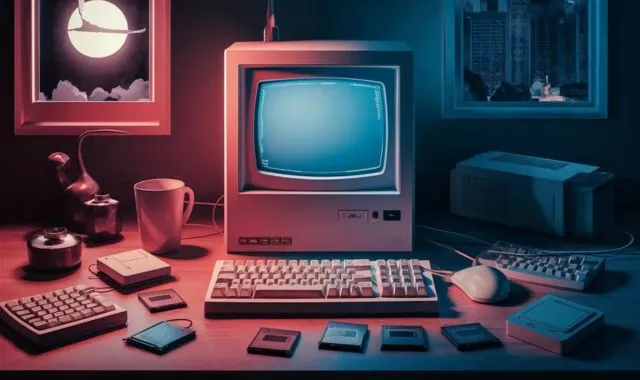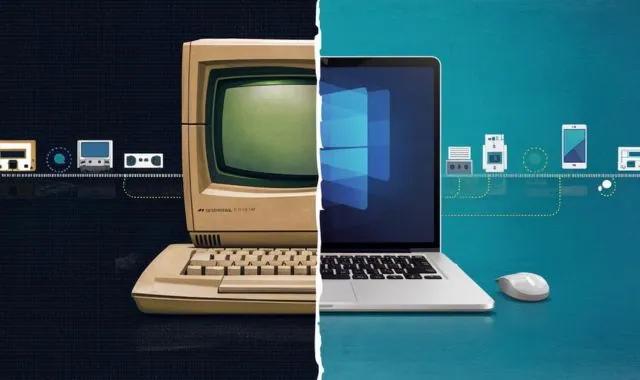Physical Address
304 North Cardinal St.
Dorchester Center, MA 02124
Physical Address
304 North Cardinal St.
Dorchester Center, MA 02124

A Dive into 1980s Technology! This article explores the rise of personal computers, cassette tapes, VCRs, and more. We’ll revisit iconic gadgets like the Walkman and brick phones, and see how these innovations paved the way for the tech we use today.

Welcome to a time capsule! Buckle up and get ready for a blast from the past as we explore the fascinating world of 1980s technology. This decade was a turning point, brimming with innovation that laid the foundation for the tech-driven world we live in today.
The 1980s witnessed the personal computer (PC) emerge from clunky desktops to colorful home computers. Early models like the Commodore 64 and the Apple II ushered in a new era of personal computing.
These early machines relied on complex command lines like MS-DOS, a challenge for non-tech-savvy users.
Thankfully, the rise of the Graphical User Interface (GUI) with user-friendly icons and menus made computers more accessible to the masses.

The 1980s were all about rocking out to your favorite tunes on the go. The Sony Walkman, a portable cassette player, became a cultural icon, allowing music lovers to soundtrack their lives.
Blank cassette tapes fueled a new trend: the mixtape. Creating personalized playlists to share with friends became a popular pastime.
However, the reign of the cassette tape was short-lived. The invention of the CD player in the late 1980s offered superior sound quality and portability, leading to the slow demise of the cassette tape.
Friday nights in the 1980s often meant a trip to the local Blockbuster. The rise of video rentals fueled by the invention of the VCR (Video Cassette Recorder) revolutionized home entertainment.
No longer confined to cinema schedules, viewers could now rent and watch movies at their own convenience.
The VCR also empowered viewers to record their favorite shows, allowing them to control their viewing habits in a way never seen before. This era eventually gave way to DVDs and the rise of streaming services, marking the end of the VHS era.

Communication in the 1980s had a distinct character. Beepers, with their limited one-way messaging capabilities, were the early predecessors of text messaging. Fax machines, though slow, offered a reliable way to transmit documents over long distances.
A simple beep meant a message awaited you, a far cry from the instant messaging capabilities of smartphones today.
Faxes were the workhorses of business communication, ensuring important documents reached their destinations.
Answering machines, a novelty in the early 80s, ensured you never missed a call, even if the recorded messages were sometimes tinny and prone to malfunction.
The 1980s were the dawn of the cellular revolution. Early mobile phones were bulky, with short battery life and expensive call charges.
Owning a cellular phone in the 80s was a status symbol, a sign of affluence and early adoption of cutting-edge technology.
These “brick phones” eventually evolved into more portable “bag phones,” paving the way for the sleek smartphones we use today.
The 1980s were the golden age of arcade games. Pixels danced on screens as gamers battled aliens in Space Invaders or navigated mazes with Pac-Man.
The rise of home consoles like the Nintendo Entertainment System (NES) brought arcade experiences into living rooms, sparking a new era of home gaming.
The battle for living room supremacy between consoles continues today, but the seeds were sown in the vibrant arcade culture of the 1980s.
The 1980s offered instant gratification with Polaroid cameras. These iconic cameras allowed you to see your photos develop right before your eyes.
Polaroid cameras captured memories in a tangible way, a stark contrast to the digital age’s reliance on screens.
Data storage in the 80s relied on floppy disks, bulky and prone to data loss. Imagine carrying around a stack of floppy disks to hold the amount of data a modern flash drive can store in your pocket!
The 1980s witnessed the birth of the internet, though it was a far cry from the web we know today. Dial-up connections resulted in ear-splitting screeches and glacial download speeds, but the seeds of a digitally connected world were sown.
Early websites were text-heavy with primitive graphics, but they laid the foundation for the information explosion and global connectivity of the modern internet.
CD-ROMs offered a vast leap in storage capacity compared to floppy disks. This revolutionized software distribution, multimedia applications, and eventually paved the way for the widespread adoption of CDs for music.
The impact of 1980s technology extends far beyond the gadgets themselves. It fostered a spirit of innovation and accessibility that continues to shape our technological landscape. Here’s how:
The personal computer, once a niche tool, became more affordable and user-friendly in the 80s. This opened doors for a wider range of people to engage with technology, paving the way for today’s ubiquitous tech culture.
The 80s saw a boom in consumer electronics, empowering individuals to choose and customize their technological experiences. This consumer-driven approach continues to influence the development and marketing of new tech products.
The rapid advancements of the 80s fostered a spirit of “anything is possible” when it comes to technology. This continues to inspire inventors, developers, and entrepreneurs to push boundaries and create groundbreaking solutions.
From the immersive worlds of arcade games to the convenience of home video rentals, 1980s tech showed the power of technology to entertain and enrich our lives. This focus on entertainment remains a driving force in the development of new technologies like virtual reality and streaming services.
The 1980s were a pivotal decade in technological history. While the bulky hardware and primitive software may seem quaint today, they represent a significant leap forward. By taking a trip down memory lane, we gain a deeper appreciation for the evolution of technology and the exciting possibilities that lie ahead.

In conclusion, the 1980s technology were a vibrant era that laid the foundation for the tech-driven world we live in today. From the rise of the personal computer to the convenience of the VCR, these advancements transformed how we communicate, work, and entertain ourselves. While the technology itself may seem outdated, the spirit of innovation and the focus on user experience that emerged in the 80s continue to shape our technological landscape. As we move forward, understanding the history of technology allows us to appreciate the progress made and fuels our vision for the exciting possibilities that lie ahead.
A: Early models like the Commodore 64 and the Apple II were popular home computers in the 1980s.
A: The Sony Walkman, a portable cassette player, allowed people to listen to music on the go, revolutionizing portable entertainment.
A: The VCR (Video Cassette Recorder) allowed people to rent and watch movies at their convenience, giving them more control over their viewing habits.
A: Beepers, the early predecessors of text messaging, offered a one-way notification system, alerting you that a message awaited you.
A: Early mobile phones were bulky, had short battery life, and expensive call charges, but they were a status symbol for those on the cutting edge of technology.
A: Pac-Man, Donkey Kong, and Space Invaders were among the many popular arcade games of the 1980s, later brought home by console systems like the NES.
A: Polaroid cameras offered instant gratification, allowing you to see your photos develop right before your eyes.
A: Floppy disks were the primary storage medium for computers in the 1980s, though they had limited storage capacity and were prone to data loss.
A: The early internet of the 1980s was a far cry from today’s web. Dial-up connections were slow, and websites were text-heavy with primitive graphics. However, it laid the foundation for the future explosion of information and global connectivity.